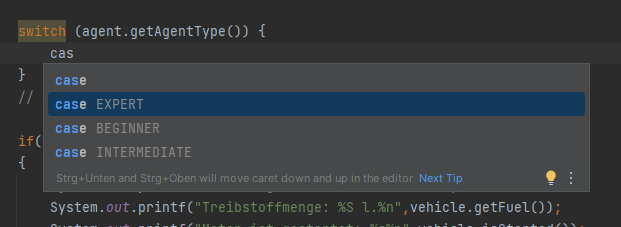Manchmal wollen wir Objekte anhand bestimmter Typen oder Eigenschaften unterscheiden.
Gleichzeitig wollen wir jedoch dem Client Code nur zuvor festgelegte Werte erlauben.
Das ist mit sogenannten enums, also Aufzählungen möglich.
Aufbau
Enums bzw. deren Konstanten sind statische Attribute, die für Vergleiche herangezogen werden können.
public enum AgentType {
BEGINNER ("Agent für einfache Aufträge"),
INTERMEDIATE ("Agent für mittlere Aufträge"),
EXPERT ("Agent für schwierige Aufträge");
private final String label;
AgentType(String label) {
this.label = label;
}
public String getLabel() {
return this.label;
}
@Override
public java.lang.String toString() {
return this.getLabel();
}
}Verwendung
Im Folgenden wird die soeben deklarierte enum in einer anderen Klasse verwendet:
public abstract class Agent {
protected ArrayList<Vehicle> vehicles = new ArrayList<>();
protected ArrayList<Equipment> equipment = new ArrayList<>();
protected AgentType agentType = AgentType.BEGINNER;
// ...
}public class Human extends Agent {
protected String firstname;
protected String lastname;
public Human(String firstname, String lastname, ArrayList<Vehicle> vehicles, ArrayList<Equipment> equipment, AgentType agentType) {
this.firstname = firstname;
this.lastname = lastname;
super.vehicles = vehicles; // Statt super funktionert auch this, da Human ja von Agent geerbt hat.
super.equipment = equipment;
super.agentType = agentType;
}
// ...
}Client Code
Nun können wir im Client Code mit der enum arbeiten:
public class Main {
public static void main(String[] args) {
Agent bond = new HumanBuilder()
.setFirstname("James")
.setLastname("Bond")
.addVehicle(new CarBuilder().createCar())
.addEquipment(new Weapon("Pistole"))
.setType(AgentType.EXPERT)
.createHuman()
;
System.out.println(bond.getAgentType());
switch (bond.getAgentType()) {
case INTERMEDIATE:
// tu was
break;
case EXPERT:
case BEGINNER:
// tu was anderes
break;
default:
// ansonsten tu dies und das
}
}
}Die meisten IDEs schlagen während der Notierung der switch-Anweisung sogar mögliche Fälle vor:



